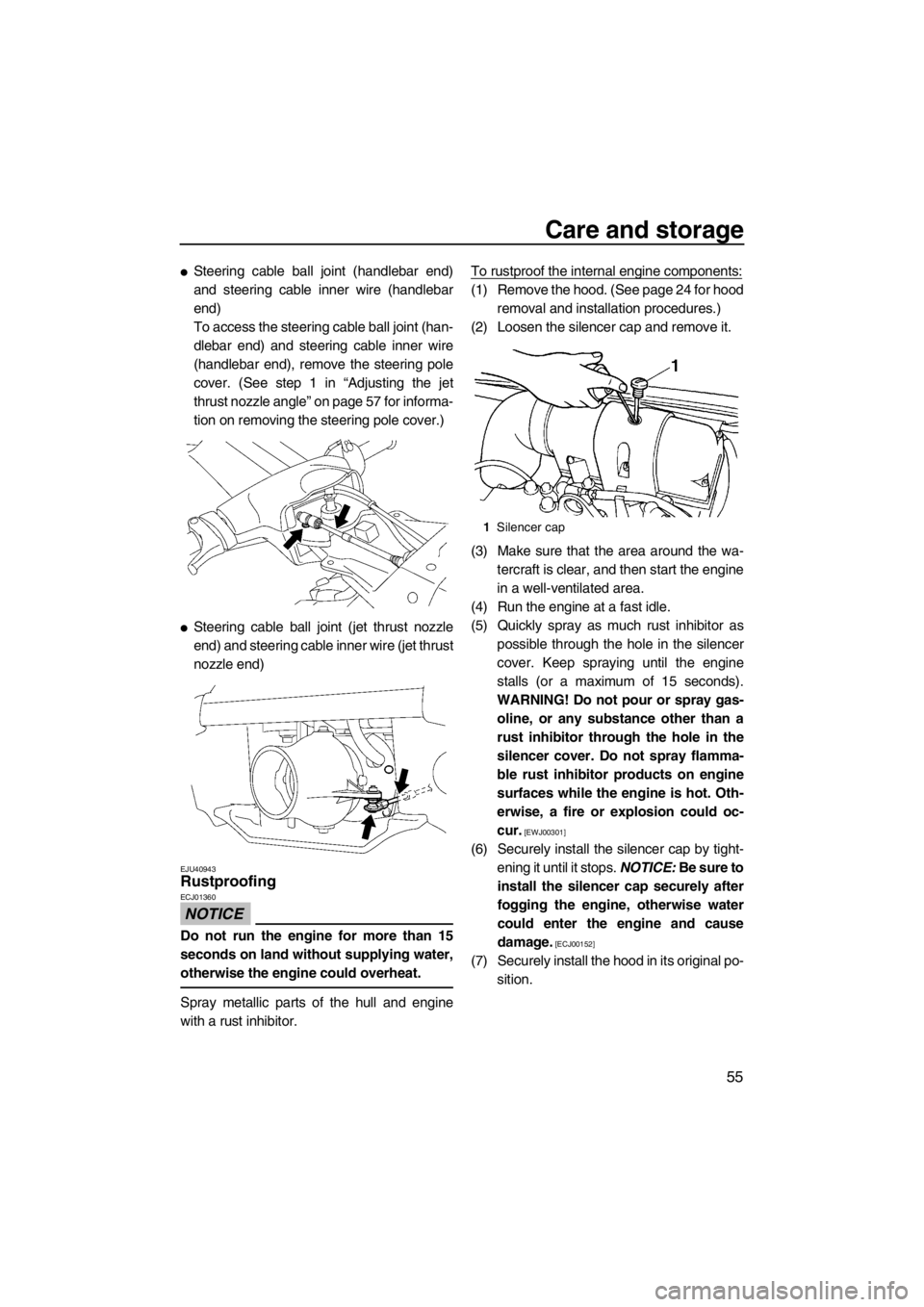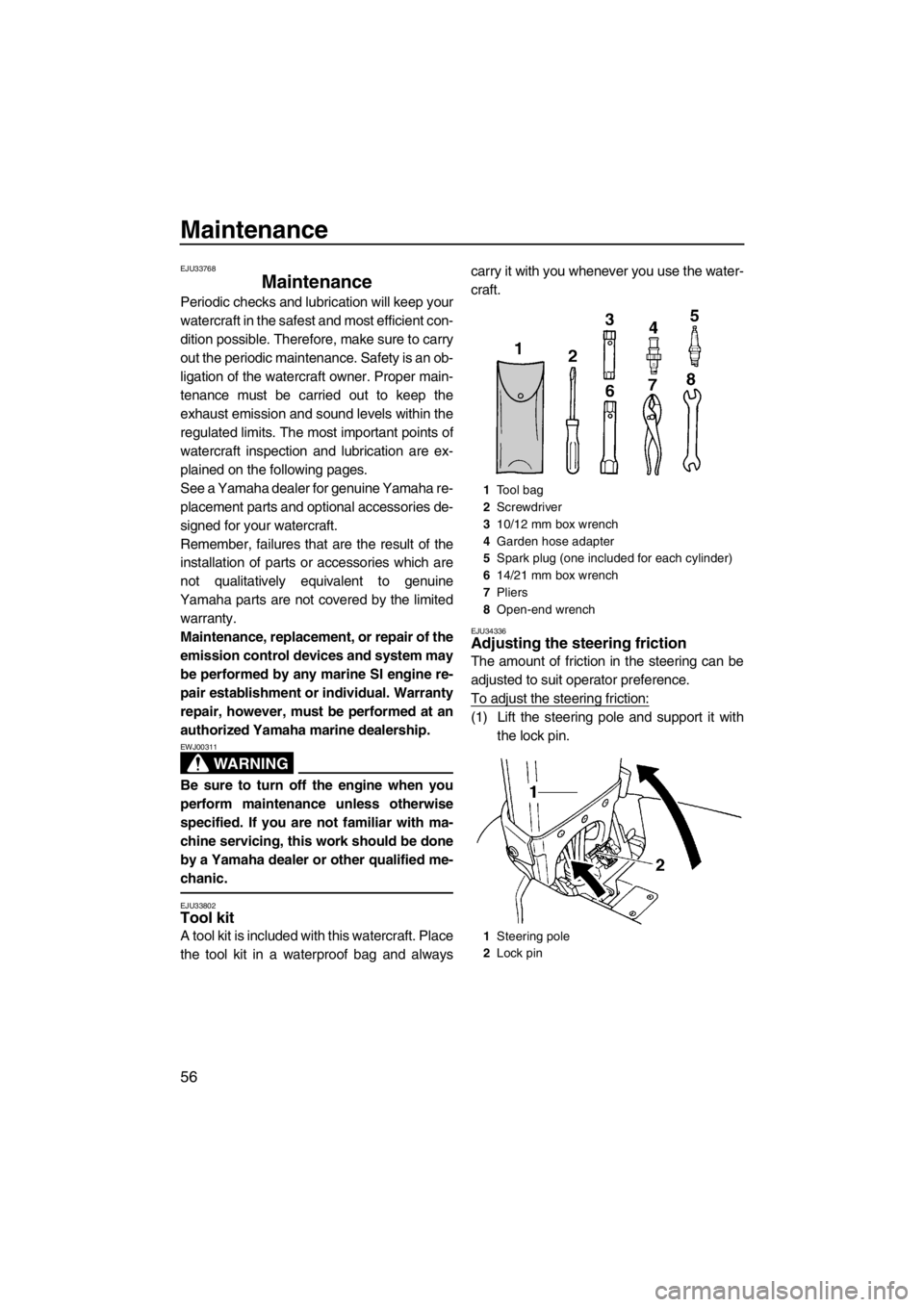2013 YAMAHA SUPERJET roof
[x] Cancel search: roofPage 6 of 78

Table of contents
Capsized watercraft ......................... 48
Beaching the watercraft ................... 49
Operating in weeded areas ............. 49
After removing the watercraft from the water ...................................... 49
Care and storage ............................. 50Post-operation care ...................... 50
Flushing the cooling water
passages ...................................... 50
Cleaning the watercraft ................... 51
Battery care ..................................... 51
Long-term storage ........................ 54
Cleaning .......................................... 54
Lubrication ....................................... 54
Rustproofing .................................... 55
Maintenance..................................... 56 Maintenance ................................. 56
Tool kit ............................................. 56
Adjusting the steering friction .......... 56
Adjusting the jet thrust nozzle
angle ............................................ 57
Periodic maintenance chart ............. 59
Checking the spark plugs ................ 60
Lubrication points ............................ 61
Checking the fuel filter ..................... 61
Adjusting the choke cable ............... 61
Adjusting the carburetor .................. 62
Specifications .................................. 63 Specifications ................................ 63
Trouble recovery ............................. 64 Troubleshooting ........................... 64
Troubleshooting chart ...................... 64
Emergency procedures ................ 66
Cleaning the jet intake and
impeller ........................................ 66
Jumping the battery ......................... 67
Replacing the fuse ........................... 67
Towing the watercraft ...................... 68
Submerged watercraft ..................... 68
UF2F75E0.book Page 2 Thursday, July 5, 2012 8:50 AM
Page 18 of 78

Safety information
12
●Avoid being hit by another boat. You should
always take the responsibility to watch for
traffic; other boaters may not be watching
for you. If they do not see you, or if you ma-
neuver more quickly than other boaters ex-
pect, you risk a collision.
●Maintain a safe distance from other boats
and watercraft, and also watch for ski ropes
or fishing lines. Obey the “Safe boating
rules” and be sure to check behind you be-
fore making a turn. (See “Safe boating
rules” on page 14.)
EJU30840
Recommended equipment
The following items should be carried on
board your watercraft:
●Sound-signaling device
You should carry a whistle or other sound-
signaling device that can be used to signal
other boats.
●Visual distress signals
It is recommended that a pyrotechnic de-
vice, which is approved by the appropriate
authorities, be stored in a waterproof con-
tainer on your watercraft. A mirror can also
be used as an emergency signal. Contact a
Yamaha dealer for more information.
●Watch
A watch is helpful so you will know how long
you have been operating the watercraft.
●Towline
A towline can be used to tow a disabled wa-
tercraft in an emergency.
UF2F75E0.book Page 12 Thursday, July 5, 2012 8:50 AM
Page 31 of 78

Equipment operation
25
To install the hood:
(1) Position the hood on the deck so that thetwo projections at the front of the hood fit
under the two stays on the deck.
(2) Push down on the hood latch, and then turn the knob to the “LOCK” position to
securely lock the hood in place.
(3) While holding the steering pole, move the lock pin to the stowed position, and then
lower the steering pole.
EJU36002Bow rope hole
The bow rope hole is used to attach a rope to
the watercraft when transporting, mooring, or towing it in an emergency. (See page 68 for
information on towing the watercraft.)
EJU36011Stern rope hole
The stern rope hole is used to attach a rope to
the watercraft when mooring it.
EJU31675Storage pouch
The storage pouch is located on the bottom of
the hood.
Use the storage pouch to store the own-
er’s/operator’s manual, tool kit, and other
small items. The storage pouch is not de-
signed to be waterproof. If you carry objects
that must be kept dry, put them in a water-
proof bag.
To remove the storage pouch:
(1) Remove the hood. (See page 24 for hood
removal and installation procedures.)
LOCKOPEN
1 Bow rope hole
1 Stern rope hole
UF2F75E0.book Page 25 Thursday, July 5, 2012 8:50 AM
Page 61 of 78

Care and storage
55
●Steering cable ball joint (handlebar end)
and steering cable inner wire (handlebar
end)
To access the steering cable ball joint (han-
dlebar end) and steering cable inner wire
(handlebar end), remove the steering pole
cover. (See step 1 in “Adjusting the jet
thrust nozzle angle” on page 57 for informa-
tion on removing the steering pole cover.)
●Steering cable ball joint (jet thrust nozzle
end) and steering cable inner wire (jet thrust
nozzle end)
EJU40943Rustproofing
NOTICE
ECJ01360
Do not run the engine for more than 15
seconds on land without supplying water,
otherwise the engine could overheat.
Spray metallic parts of the hull and engine
with a rust inhibitor.To rustproof the internal engine components:
(1) Remove the hood. (See page 24 for hood
removal and installation procedures.)
(2) Loosen the silencer cap and remove it.
(3) Make sure that the area around the wa- tercraft is clear, and then start the engine
in a well-ventilated area.
(4) Run the engine at a fast idle.
(5) Quickly spray as much rust inhibitor as possible through the hole in the silencer
cover. Keep spraying until the engine
stalls (or a maximum of 15 seconds).
WARNING! Do not pour or spray gas- oline, or any substance other than a
rust inhibitor through the hole in the
silencer cover. Do not spray flamma-
ble rust inhibitor products on engine
surfaces while the engine is hot. Oth-
erwise, a fire or explosion could oc-
cur.
[EWJ00301]
(6) Securely install the silencer cap by tight- ening it until it stops. NOTICE: Be sure to
install the silencer cap securely after
fogging the engine, otherwise water
could enter the engine and cause
damage.
[ECJ00152]
(7) Securely install the hood in its original po- sition.
1Silencer cap
UF2F75E0.book Page 55 Thursday, July 5, 2012 8:50 AM
Page 62 of 78

Maintenance
56
EJU33768
Maintenance
Periodic checks and lubrication will keep your
watercraft in the safest and most efficient con-
dition possible. Therefore, make sure to carry
out the periodic maintenance. Safety is an ob-
ligation of the watercraft owner. Proper main-
tenance must be carried out to keep the
exhaust emission and sound levels within the
regulated limits. The most important points of
watercraft inspection and lubrication are ex-
plained on the following pages.
See a Yamaha dealer for genuine Yamaha re-
placement parts and optional accessories de-
signed for your watercraft.
Remember, failures that are the result of the
installation of parts or accessories which are
not qualitatively equivalent to genuine
Yamaha parts are not covered by the limited warranty.
Maintenance, replacement, or repair of the
emission control devices and system may
be performed by any marine SI engine re-
pair establishment or individual. Warranty
repair, however, must be performed at an
authorized Yamaha marine dealership.
WARNING
EWJ00311
Be sure to turn off the engine when you
perform maintenance unless otherwise
specified. If you are not familiar with ma-
chine servicing, this work should be done
by a Yamaha dealer or other qualified me-
chanic.
EJU33802Tool kit
A tool kit is included with this watercraft. Place
the tool kit in a waterproof bag and always carry it with you whenever you use the water-
craft.
EJU34336Adjusting the steering friction
The amount of friction in the steering can be
adjusted to suit operator preference.
To adjust the steering friction:
(1) Lift the steering pole and support it with
the lock pin.
1Tool bag
2 Screwdriver
3 10/12 mm box wrench
4 Garden hose adapter
5 Spark plug (one included for each cylinder)
6 14/21 mm box wrench
7 Pliers
8 Open-end wrench
1 Steering pole
2 Lock pin
UF2F75E0.book Page 56 Thursday, July 5, 2012 8:50 AM
Page 77 of 78

Index
Operation requirements ........................... 10
P
Periodic maintenance chart...................... 59
Post-launch checks .................................. 39
Post-operation care .................................. 50
Pre-launch checks.................................... 35
Pre-operation check points ...................... 35
Pre-operation checklist............................. 33
Primary Identification (PRI-ID) number ...... 1
R
Recommended equipment ....................... 12
Rustproofing ............................................. 55
S
Safe boating rules .................................... 14
Safety equipment check ........................... 39
Spark plugs, checking .............................. 60
Start switch............................................... 19
Starting off ................................................ 45
Starting the engine on water .................... 41
Steering friction, adjusting ........................ 56
Steering pole ............................................ 20
Steering pole check.................................. 37
Steering system ....................................... 20
Steering system checks ........................... 36
Stern rope hole......................................... 25
Stopping the engine ................................. 43
Stopping the watercraft ............................ 45
Storage pouch .......................................... 25
Storage pouch checks.............................. 38
Submerged watercraft .............................. 68
Switch checks .......................................... 38
T
Throttle lever ............................................ 20
Throttle lever checks ................................ 37
Tool kit...................................................... 56
Towing the watercraft ............................... 68
Transporting ............................................. 31
Troubleshooting ....................................... 64
Troubleshooting chart .............................. 64
Turning the watercraft .............................. 43
W
Water separator ....................................... 22
Water separator check ............................. 36
Watercraft characteristics......................... 13
Watercraft control functions ..................... 19
UF2F75E0.book Page 2 Thursday, July 5, 2012 8:50 AM